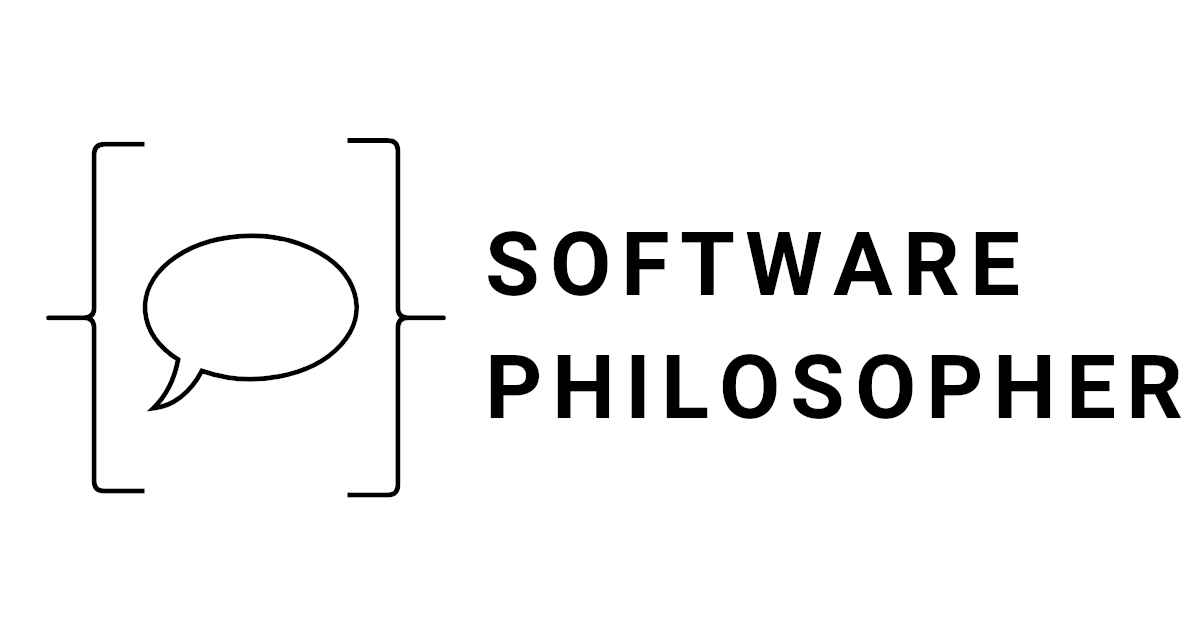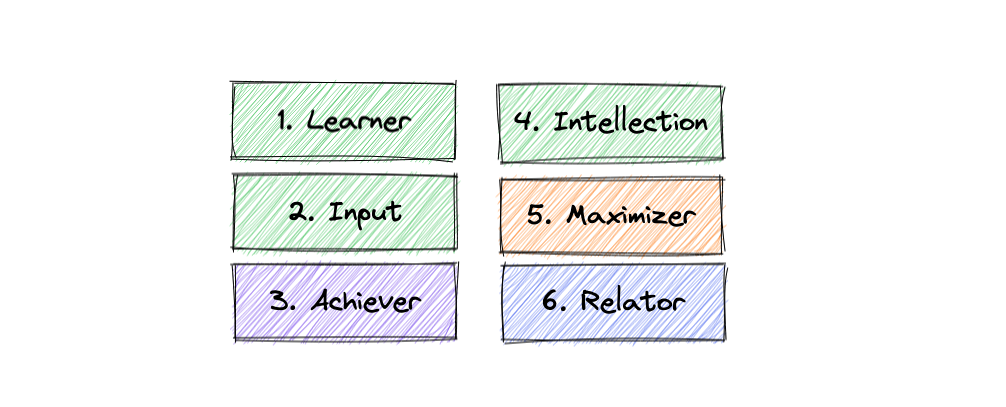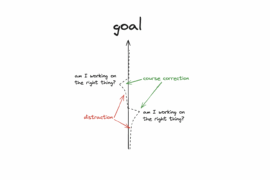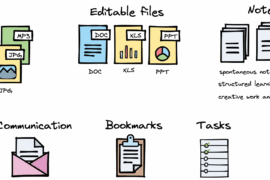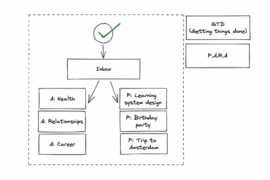Introduction
Around 6 years ago I first heard the name CliftonStrengths. I was introduced to it by my manager, and I had a chance to do the assessment myself. Despite my skepticism I was surprised how accurate it seemed to be. Since that time I’ve been working on my set of strengths to identify my blind spots, and to improve the way I use them to achieve my goals.
What is CliftonStrengths assessment?
Essentially it is a tool that helps us build self-awareness and identify our strengths. It resembles filling out a questionnaire. There’re 177 statements and we have to choose which one best describes us.
E.g. on the one side we have a statement like “Starting conversations is an effort for me”, on the other side there is a statement “I get a rush from striking up a conversation with a stranger”. We have to position ourselves on this -2 to 2 scale.

At the end we get our personalized report. The CliftonStrengths assessment created a model to describe the results and it comprises 34 strengths grouped into four themes:
- EXECUTING themes help you make things happen.
- INFLUENCING themes help you take charge, speak up and make sure others are heard.
- RELATIONSHIP BUILDING themes help you build strong relationships that hold a team together.
- STRATEGIC THINKING themes help you absorb and analyze information that informs better decisions.
For a full list of 34 strengths with their description you can go to: https://www.gallup.com/cliftonstrengths/en/253715/34-cliftonstrengths-themes.aspx
Which strengths are the best?
One thing to remember is that there is no absolute score we can get from the assessment. There are no better or worse strengths. They just describe the way we behave or think. Each of them has their bright and dark sides. By working on them we can achieve better results and mitigate the influence of their dark sides. The strengths by no means give us a clue which career we should follow – we can work in any profession with a completely different set of strengths, and still be successful.
Why should I care?
Is it worth doing this and paying for this? It depends on our expectations. For people who constantly seek opportunities to become better I think it’s worth it. The results bring a lot of self-awareness and give useful advice to follow. And it doesn’t have that feeling of very vague and general psychotest from tabloids and magazines. I had this disquieting feeling while reading the report that they knew me quite well, even though they hadn’t met me.
Additionally, if we work in a long-lived team I think it’s a great idea for everyone in the team to do the assessment, and have a workshop to share and discuss the results. This may help better understand other team members’ motivation and approach.
My results in relation to software engineering
In the following sections I would like to present my results and my top talents, especially how they present themselves in the context of working as a software engineer. It is a challenging task to ascribe some behaviors to specific strengths in isolation but I will try to do my best.
1 – Learner – addicted to learning
The strength comes from a Strategic thinking theme. Its description from the report is: You have a great desire to learn and want to continuously improve. The process of learning, rather than the outcome, excites you.
To me it meant that I found myself addicted to learning. The process of learning was more exciting to me than the outcome itself. I was very keen to start a new journey every now and then, because at the beginning of learning a new topic you learn the most. The “new ideas” curve is very steep (excitement), and after some time your learning pace plateaus (boredom). That’s the time when I jump onto something else.
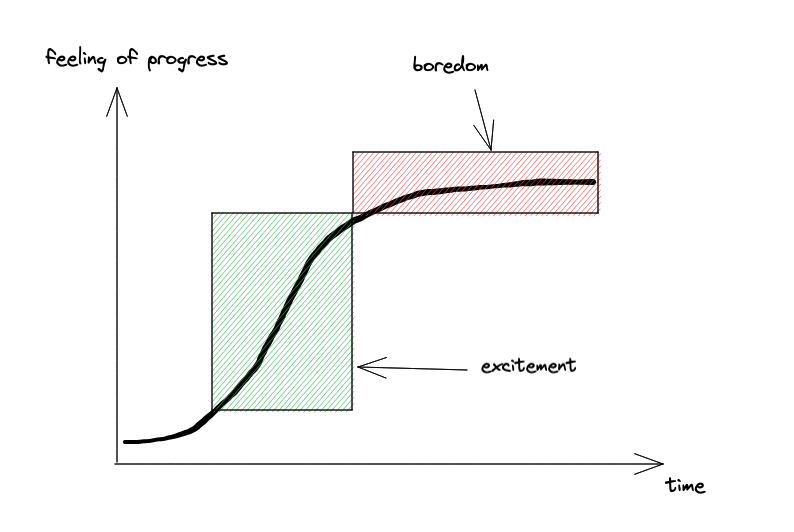
This may become a big problem if you are a software engineer. In the software industry there is ALWAYS something new to learn. New ideas, new technologies, new approaches. If we’re not careful enough we may have a constant feeling of FOMO (fear of missing out).
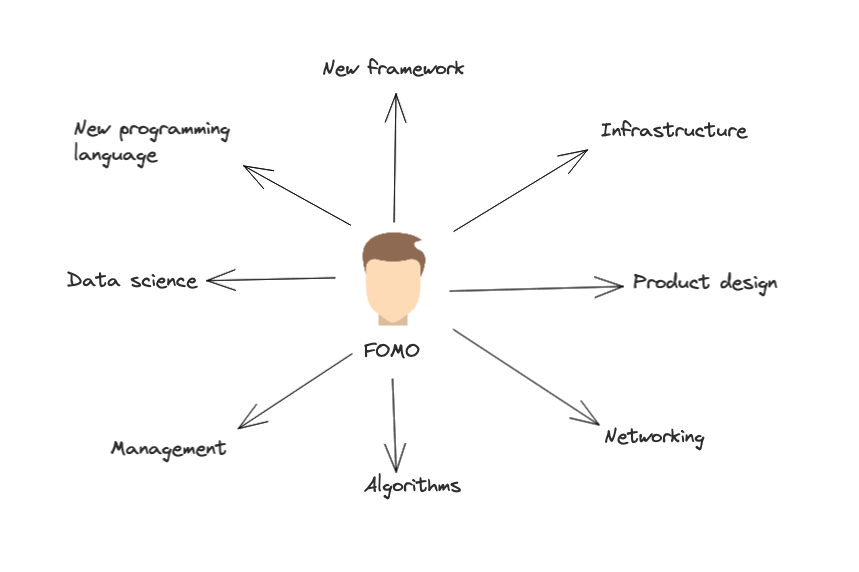
When I identified that risk it struck me that it could actually be a huge advantage, if only I directed my learning eagerness into more purposeful areas. The software industry actually requires us to constantly learn new things. But there’s a subtle difference between learning new things to become better at something and learning new things to become mediocre at even more topics.
Having tamed this addiction to learning I now feel I can release this beast in a controlled manner. When I feel a bit burned out, tired or bored, I let myself check out something new just to boost my motivation.
2 – Input – the garbage man
The strength comes from a Strategic thinking theme. Its description from the report is: You have a need to collect and archive. You may accumulate information, ideas, artifacts or even relationships.
I was collecting everything that I thought could be useful by any chance. I was taking notes, collecting links, bookmarks, photos, memes, leaflets. But I realized that I almost never returned to any of those. It was an add-only process. And it was introducing a lot of chaos. If from time to time I needed to access something, I couldn’t find it because there were so many of them spread across multiple places.
I also discovered that I was wasting a lot of time on meta-work. It felt good to create various excel sheets, folder structures for notes and so on. But until I had reached the point when I could actually make use of it, I usually found something else to do.
To mitigate the issue, I sat down and wrote down all things that I may need to collect or archive somehow. Having a big picture I could name all the things I need to analyze, and also streamline the process a bit – to reduce the number of tools to use for example. After spending some time on it, I ended up with something I called a “personal framework”. Essentially it depicts my thought process when I have a new task in my inbox. It helps me decide what to do in various life situations e.g. someone recommended a movie to me that I could watch with my wife – I can put it into my special excel sheet. Or I have a new English word that I would like to learn – depending on where I am right now I can either write it down in the notebook or put it into google keep. And so on.
It’s worth mentioning that this is an iterative process and it is still ongoing. I’ve tested multiple tools, and migrated my resources a few times already.
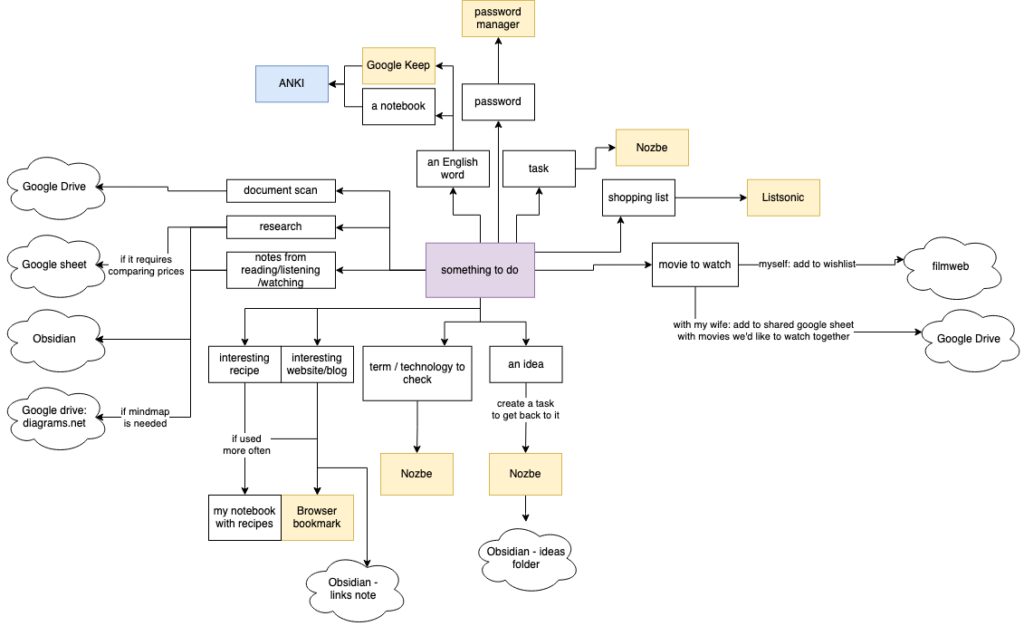
Because I’m more aware of where I store different kinds of information, it helps me to be better organized at work. Over time I developed an intuition that suggests to me what would be useful to store e.g. code snippets, links to different versions of the software, etc. I ask myself “if I had to do it in a year will I remember what to do?” and if the answer is negative I write down the steps that can help me in the future. Additionally, I ask another question – I needed this in a year how I would search for it – and this way I also enable searchability in my system.
I put some effort into improving my system. It continuously evolves, and I made an attempt to describe it in How do I organize my notes – P.A.R.A. and evergreen notes post.
3 – Achiever – there’s no time to rest, we have to keep moving
The strength comes from an Executing theme. Its description from the report is: You work hard and possess a great deal of stamina. You take immense satisfaction in being busy and productive.
I like completing tasks. There’s this amazing enjoyment of clicking on the item in the to-do list app (I use Nozbe), and seeing it being crossed out. Sometimes I even add tasks that I had completed before just to mark them as completed.
But there’s a blur line between being busy and being productive. It’s not difficult to take on too many responsibilities. “Could you help me with this? Yeah, sure”, “do you think you could take over this task? Ok”, “who could lead this analysis? I could”.
From one point of view, it may make sense to have multiple things to do. When one of them is blocked, I could work on something else. But this is just theory. In practice, I used to drown in chaos. I would talk to someone, write something down on a piece of paper, have a discovery about something else, write it in Google Keep, and at the end of the day feel useless, because I couldn’t finish a single thing.
I needed a system. I came across GTD (Getting Things Done, 2001) by David Allen and it helped me a bit.
I introduced a single backlog of things to do. That gave me an overview of what is actually to be done. That was useful since now I could have a brief look at the list and get an impression if it’s “too much” or if I can take on something else.
Additionally I learned how to phrase my tasks. Before it used to be very vaguely stated, like “better architecture”, “dentist” etc. Thus I had a tendency to procrastinate because there was immediately brain work to do, even before I start the task itself – “what is actually to be done here?”. I changed the habit. Now all my tasks are “actionable”. “Schedule a call to talk about the architecture”, “look up dentists in my area”.
However, adding things to a list is not enough for the system to work properly. I needed to develop one more habit which is going through my tasks regularly. During this process I could delete irrelevant ones, rephrase others or put a deadline to push myself to start it.
I treat my system as “pull based”, which means it’s me who decides what I’m going to do next, and I try to avoid as much as possible being distracted by things that try to push their way forward towards my attention. I simply disabled all notifications.
I read a book called Deep Work by Cal Newport (2016), which made me realize that, of course I can feel that I achieve something by doing many small steps here and there, but usually it’s the deep work that really matters and gives the most satisfaction. The time when I can sit down on a problem, focus, go into a “flow” mode , and just solve the problem once and for all instead of just trying to nibble it in a chaotic rush.
There was this quote from President Eisenhower (who in turn was quoting Dr J. Roscoe Miller) “I have two kinds of problems: the urgent and the important. The urgent are not important, and the important are never urgent.”. The deep work is usually important and not urgent.
The dark side of the achiever’s strength is that sometimes there are just too many things to do. There’s this infinite stream of issues, tasks, and requests. It’s on us to tame it, otherwise, we have to sacrifice other aspects of our lives: sleep, family, health – and these are things with a deferred payback so we don’t feel immediate consequences.
We may create a matrix built on top of the aforementioned quote (sometimes referred to as “The Eisenhower Matrix“). Columns are urgent/not urgent, rows are important/not important. If we deliberately classify some things as “not urgent, not important” we just can maturely decide not to do them and release some time.
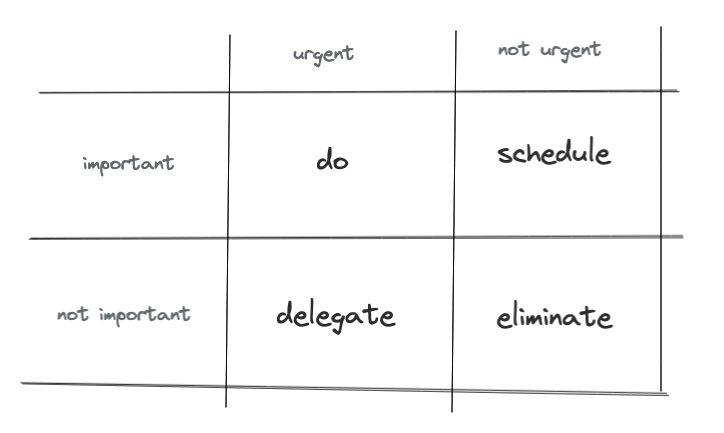
I found it very easy to put blinders on and focus solely on completing the next task. That is an easy path to frustration. As mentioned before there’s an infinite stream of things to do. We must remember that we complete the tasks for any reason. I learned that it’s massively important to celebrate success, to turn your head back and see this enormous distance between where we’re now and where we were two months ago.
The achiever makes my job an important aspect of my life, which unfortunately makes me take some events more personally and emotionally than others do. It requires some effort to be more present and self-aware to identify these situations when they happen and to do something with them. But it’s attainable for example by mindfulness meditation (to retain focus) or a therapy (to distance yourself).
4 – Intellection – analysis paralysis
The strength comes from a Strategic thinking theme. Its description from the report is: You are characterized by your intellectual activity. You are introspective and appreciate intellectual discussions.
The “intellection” helps me enhance my actions with empathy. When I do something I try to think how others would understand it, if it’s clear to them, if I can fix it, or avoid similar mistakes in the future.
To have these kinds of thoughts I need space. I realized that it’s important for me to carve out some time during the work day to, for example, go for a short walk, look at things from a 10,000 foot view, let them rearrange in my mind. It’s very easy to not see the forest when you’re among trees. My wife sometimes laughs at me when sees me laying on the sofa in the middle of the day, but I still consider it work, because I lay there trying to look at the problem from a different angle.

But the downside of this thinking everything through is that sometimes I think way too much. I have a tendency to question myself, “what’s the point?”, “why am I doing this?”. I fall into analysis paralysis when I have to decide on something because I immediately see all the disadvantages of all solutions.
This strength sometimes means that I need to be alone. But because when I’m alone I think about various options and what I can do better, I realize that I need to keep seeking a balance between working alone, and working in pairs e.g. pair programming to maintain a good knowledge-sharing level during my daily work.
👉 Pair programming is one of the ways to improve knowledge sharing (or a bus factor) within a team. You can read about more in this post.
The ability to digest events and what happens around me allows me to appreciate the past and my achievements as well as make better decisions and accept my imperfection. It let me realize that growing as a specialist is a process that is full of failures. And failures aren’t necessarily a bad thing – they push us to improve next time and they are a learning opportunity. (Syed, 2015)
5 – Maximizer – it’s not optimal enough!
The strength comes from an Influencing theme. Its description from the report is: You focus on strengths as a way to stimulate personal and group excellence. You seek to transform something strong into something superb.
Whatever I do, I always try to do it better. It’s never optimal enough! Competing with others is not something I’m the big fan of (Competition is my 29th strength), but I constantly compete with myself pushing the limit further and further. I always seek ways to improve the work process, the way I collect information, the way I learn and so on. At work it allows me to think in advance if I can do it in an optimal way, e.g. instead of doing this manually 200 times, maybe I can write a script?
Unfortunately, this is the strength that I feel the least control over. It continually makes me unhappy with my results. From time to time I experience this madness of improving things that don’t even need improvement. Just to satisfy my urge to do everything the best possible way. This also means analysis paralysis because I have to find the top-notch choice.
6 – Relator – I don’t know you, I don’t trust you
The strength comes from a relationship building theme. Its description from the report is: You enjoy close relationships with others. You find deep satisfaction in working hard with friends to achieve a goal.
In theory the basic CliftonStrengths report has top 5 strengths, but this one is also very important to me and I feel its influence more than for example 6th or 7th place.
This strength means that I’m the most productive and happy in an environment where I feel welcome and have a better connection with people around me. I’m focused more on a long-running professional relationship. When I join the team it takes some time for me to acclimate – especially since I consider myself shy. But after some time it’s an important part of a day to day work to maintain a good relationship. I like to join activities together, talk about how they feel and be empathetic in general.
This usually means that I would rather think twice before I change the job or project. Building relationships is always an effort and a cost to that decision.
How to do the CliftonStrengths assessment?
It’s possible to buy the access in two ways – either for top 5 or all 34 strengths.
There’s an option to buy the top 5 first, and then extend without doing the assessment a second time – it’s just more expensive. At the moment the price is 20 USD for the top 5.
https://store.gallup.com/p/en-us/10108/top-5-cliftonstrengths
How to develop our strengths?
To develop our strengths we can start by reading the report first. It is personalized, which means it describes us and gives us suggestions in relation to all other 4 talents from our top 5.
E.g. If I have 1. Learner, 2. Input, etc.. I will see a different report than someone who has 1. Learner, 2. Strategic etc…
Additionally CliftonStrengths has its own YouTube channel where they post videos and interviews with certified coaches who talk about how we can work with our results.
There are also a few books about Gallup CliftonStrengths.
And of course we can have a session with a certified coach but this is the most expensive option.
Conclusion
CliftonStrengths assessment is a tool to build self-awareness. It helps us to identify our strengths. It gives personalized reports to work with. The results can also be useful within long running teams. The results don’t tell us which profession we should choose, but instead they show us how we’re going to work in that profession. I analyzed my results from the angle of the software engineering. These are
- Learner – I have to be careful when choosing topics to learn because I’m addicted to learning. But when controlled I can keep up with a changing technology.
- Input – By introducing a system of storing information I was able to simplify the ever-growing list of places where I keep my notes and tasks. Therefore, I’m always ready to retrieve needed information on-demand.
- Achiever – I have a tendency to work hard and always push forward, so I have to remember that I should leave some space to celebrate past successes
- Intellection – I need to think things through. Sometimes it leads to analysis paralysis, but in general it’s required for me to have a dedicated time to process information in order to be productive.
- Maximizer – Everything could be improved which makes me unhappy sometimes so I had to make some effort to convince myself to accept imperfection
- Relator – I care about relationships within a team and I engage more if I have familiar people around me. This also makes it harder for me to adapt to a new place.
The CliftonStrengths assessment is a paid tool. After solving the test, we get access to the report. There are multiple ways we can work to improve our strengths including
- reading the report itself
- reading books about CliftonStrengths
- watching YouTube channels
- or having a session with a certified coach.
References
- Allen, D., (2001) Getting Things Done: The Art of Stress-Free Productivity, Penguin Books
- Syed, M., (2015) Black Box Thinking, Portfolio
- Newport, C., (2016) Deep Work: Rules for Focused Success in a Distracted World, Grand Central Publishing
Sofa image – by Phillip Goldsberry – unsplash.com
Head icons created by Smashicons – Flaticon
Images drawn in excalidraw and diagrams.net
